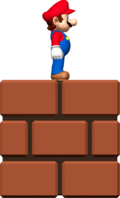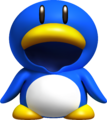New Super Mario Bros. Wii
Template:Infobox New Super Mario Bros. Wii is a sidescrolling 2.5D Mario platformer for the Wii, and the tenth game in the Super Mario series. The game was released in Oceania on November 12, in North America on November 15, and Europe on November 20, 2009; this is the first main series game to be released first in the Oceanian regions and the first and currently only Mario platformer to be originally released outside Japan or America. It is a follow-up to New Super Mario Bros., released in 2006 for the Nintendo DS. In addition to the single-player experience, New Super Mario Bros. Wii also features a multiplayer mode for up to four players. This is the first Super Mario game to feature a co-op and vs. modes at the same time since Mario Bros. It features more items, new levels and more enemies than the DS predecessor. It is also the first title to support Nintendo's new Super Guide mode.[1] The game introduces three new power-ups, the Propeller Mushroom and the Penguin Suit, which turn characters into their propeller and penguin forms respectively.
New Super Mario Bros. Wii is the first 2D platformer Super Mario title to hit a home console since Super Mario World for the SNES (released 19 years prior). To date, the game has sold over twenty-seven million copies worldwide, making it the fourth best-selling Wii game overall and the second best-selling Mario game on the system, after Mario Kart Wii.[2] New Super Mario Bros. Wii received a follow-up on the Nintendo 3DS, New Super Mario Bros. 2, and later, a sequel on the Wii U, New Super Mario Bros. U.
Story
Mario, Luigi, Blue Toad and Yellow Toad were celebrating Princess Peach's birthday, when a huge cake slides in. Immediately, Bowser Jr. (who masterminded the plot to infiltrate via the birthday cake[3]) and the Koopalings pop out and throw the cake on top of Peach and the Toads, trapping her inside and leaving the Toads stunned. From there, the villains load her onto their Airship while Mario, Luigi, Blue Toad and Yellow Toad follow closely. The Toads from the castle soon use a cannon to blast away presents containing Propeller Mushrooms and Penguin Suits so Mario and the others can obtain them, but they explode in the air and spread the items in nine worlds.[4]
When Mario and the gang finally get to the final castle, they find Bowser. One of them has to jump on a ! Switch behind Bowser to defeat him, sending him falling into the lava below. After, Mario, Luigi, Yellow Toad, and Blue Toad celebrate their victory, they see the fake Princess Peach crying in a cage. However, she turns out to be Kamek in a pink version of his robe. Kamek then powers Bowser up, making him huge. After Bowser has been powered up, the four can do nothing but flee from the giant boss. Soon they find a dead end with a huge ! Switch. They push it, and the giant Bowser falls through the floor in final defeat as the real princess is released from her cage. As they venture out, they see Luigi, Blue Toad and Yellow Toad arrive in their hot air balloons. Luigi lets Mario and Peach into his balloon and is accidentally left behind. The two Toads then offer Luigi a ride in their balloon. As they sail off, Peach asks Mario if she told him about the Secret World. If the player beats the level again, Peach will ask Mario to tell her about his adventure again.
After the credits, Larry Koopa is seen limping toward Bowser's Castle. As he collapses, Bowser Jr. walks up to him and shows him the rest of the Koopalings trying to push Bowser, who is back to normal, right side up. They finally succeed, with a huge thud, causing the castle to fall on top of them.
Gameplay features
The gameplay of the game is mostly based off of its DS predecessor. The story mode of the game can be played in either single-player mode or multiplayer cooperative mode. Players can be freely added and removed in between levels on the World Map. The camera pans as players move and it zooms in and out depending on their distance to one another. However, there is a limit, and players who are far behind lose a life.
After clearing World 1-3 for the first time, a Toad runs up and tells the heroes that Bowser Jr. ordered his minions to stuff Toads they capture into ? Blocks. If the level was cleared in single-player mode, a Goomba then appears and carries the Toad to a ? Block in World 1-1, where the player must carry him to the goal. Toads can only be rescued in single-player mode.
When a player loses a life in multiplayer, they reappear inside a bubble. The player inside the bubble can shake the Wii Remote to bring themselves closer to the other players that are currently not in a bubble. Bubbles can only burst when a player not in a bubble comes in contact with the bubble or throws a fireball, iceball, shell, or frozen enemy at the bubble. A player can place themselves in a bubble purposefully without losing a life by pressing the ![]() button on the Wii Remote or the
button on the Wii Remote or the ![]() button on the Nunchuk if it is connected. The player inside the bubble cannot be harmed by anything and retains their previous form. However, if everyone has lost all their lives, or if someone loses a life and everyone else is in a bubble, then all players have to restart the level from the beginning or the midpoint flag if the players touched it on a prior attempt. The players in bubbles return to their normal form, but do not lose any lives.
button on the Nunchuk if it is connected. The player inside the bubble cannot be harmed by anything and retains their previous form. However, if everyone has lost all their lives, or if someone loses a life and everyone else is in a bubble, then all players have to restart the level from the beginning or the midpoint flag if the players touched it on a prior attempt. The players in bubbles return to their normal form, but do not lose any lives.
When one player grabs the flagpole at the end of the level, the timer stops and the other players would have a limited amount of time to grab the flagpole before the level ends; however, there is no penalty to the players left behind other than the lost opportunity for points or a 1-Up by grabbing the flagpole.
Players play the game by holding the Wii Remote sideways or by using the Wii Remote and Nunchuk combination. If a player tilts the Wii Remote, certain actions can be performed such as changing the direction of a light or tilting special platforms when they have been activated. Players can activate these by standing on them; the color and the symbol of the character on the platform determines who is controlling them.
Shaking the Wii remote activates the spin jump, as seen in Super Mario World. Players can carry objects such as frozen enemies and barrels by ![]() (
(![]() with Nunchuk) and shaking the Wii Remote near the object.
with Nunchuk) and shaking the Wii Remote near the object.
It's possible to ride on Yoshi as well. In addition to his usual ability to devour enemies, he can retain many different objects in the game in his mouth including hammers, fireballs, iceballs, shells, Toads, power-ups, and other players. Yoshi can also use his Flutter Jump, a move first introduced in Super Mario World 2: Yoshi's Island. Similar to Super Mario World, Yoshi can eat five apples in a course to produce an egg with a power-up or 1-Up. Yoshi cannot be harmed by sharp objects and enemies such as Spinies and Piranha Plants as long as he lands on them. Yoshi(s) brought to the end of the course must be abandoned, and therefore there are only certain levels in which players can ride Yoshis.
Toad houses and enemy encounter screens return from Super Mario Bros. 3; items obtained are stored in an inventory that can be accessed with the ![]() button (
button (![]() button with the Nunchuk) on the map screen. Unlike New Super Mario Bros. and Super Mario World, there is no spare item box, so players can't activate items during levels. Pressing
button with the Nunchuk) on the map screen. Unlike New Super Mario Bros. and Super Mario World, there is no spare item box, so players can't activate items during levels. Pressing ![]() on the map allows the player to go to any previously visited world.
on the map allows the player to go to any previously visited world.
Up to five stars can appear on a player's profile. The first appears after the player has beaten Bowser for the first time (using any method), the second appears when all levels in the first eight worlds (excepting Warp Cannons/Pipes and Toad Houses) have been beaten, the third appears if all Star Coins from Worlds 1 to 8 are obtained, the fourth appears when all Star Coins in World 9 have been obtained, and the fifth appears once the player has beaten every level (including Warp Cannons, etc.) and has collected every Star Coin. The stars shine if the Super Guide block did not appear at all during the game, even if it is not used when it appears.
Super Guide
- Main article: Super Guide
Debuting in this game, the Super Guide provides players assistance to clear levels. When the player has failed to pass a level at least eight times in single player, a green box appears at the start of the level or at the checkpoint. When the player hits the green box, the level restarts in autopilot mode: a computer-controlled Luigi plays the level on his own. The Super Guide shows the player how to beat the level, but does not use shortcuts, take damage or reveal secrets. While the Super Guide is running, the player can press the ![]() button on the Wii Remote at any time to take control back; the game starts exactly where the Super Guide left off. Once the player has taken control back, they cannot turn it back on in the middle of the level. Even when the Super Guide assistance is used, the level is still considered complete, though it is now marked red, and any stars on the profile do not shine. If the player takes over, they continue to play as Luigi, rather than Mario. Losing a life as Luigi allows the player to control Mario again, without losing a life.
button on the Wii Remote at any time to take control back; the game starts exactly where the Super Guide left off. Once the player has taken control back, they cannot turn it back on in the middle of the level. Even when the Super Guide assistance is used, the level is still considered complete, though it is now marked red, and any stars on the profile do not shine. If the player takes over, they continue to play as Luigi, rather than Mario. Losing a life as Luigi allows the player to control Mario again, without losing a life.
Free-for-all
Free-for-all is a multiplayer-only mode that is selectable from the game's main menu. Every course from the main game is selectable in this mode, although the worlds have to be beated once in the main game in order to play them in Free-for-all. This mode is very similar to the main game, but there are no Midway Flags, and on the end of a level, the amount of points each chracter got is seen. However, unlike Coin Battle, the character does not say a "happy" phrase after wining, and the amount of times each player won is also not seen. Additionally, if all of the players manage to get to the Goal Pole, the level is marked on the level selection menu with a gold frame, and the words "TEAM FINISH!" will be seen for about a second. If not all players manage to reach the Goal Pole, it will be marked with a silver frame instead.
- Names in other languages
| Language | Name | Meaning | Notes |
|---|---|---|---|
| Spanish | Modo Libre[?] | Free Mode |
Levels
The game has nine worlds with a world map similar to New Super Mario Bros. There still are Toad Houses, towers, castles, Warp Cannons, Warp Pipes (in World 2), Beanstalks (in World 7) and horizontal "platform" Pipes (in World 6). Enemies also patrol the map screen. If the enemies come in contact with them, they must play an Enemy Course. Players must collect eight Toad Balloons to make a chest with a Toad trapped in it appear. If Toad is saved, three Super Mushrooms are rewarded. Each Enemy Course is different on each world. The layout of the worlds (left-right and up-down) alternates between the worlds, with the odd-numbered worlds, Worlds 1, 3, 5, and 7 all going in a horizontal left-to-right direction, and the even-numbered worlds, Worlds 2, 4, 6, and 8 all going in a vertical down-to-up direction.
There are 77 courses in the main game. Kidnapped Toads are sometimes hidden in previously beaten levels in single-player mode. If the Toad is carried to the level exit without being damaged, Mario is rewarded with three 1-Ups. However, only one 1-Up is rewarded to Mario if the Toad took damage before reaching the goal. Additionally, when Toad is saved, a Toad House opens at the starting point of the world. The type of house that appears depends on the last digit in the level timer when Toad and/or Mario touches the flagpole. If the Toad is damaged twice, it's defeated, and Mario can't bring it to the goal anymore.
Captured Toads only appear in the following levels:
Other than the game's main campaign, which can be played with up to four players, New Super Mario Bros. Wii offers special multiplayer challenges. Those challenges have some levels taken from the campaign, and some newly created levels. There is a Free for All mode and a Coin Battle mode. Free for All mode has players competing for a high score, while Coin Battle mode has them competing for the most collected coins in the level.
World 9 is unlocked after completing the game. There are eight stages in that world, and each stage is unlocked by collecting all the Star Coins in each of the preceding eight worlds.
Worlds
- World 1
- World 2
- World 3
- World 4
- World 5
- World 6
- World 7
- World 8
- World 9 (Bonus World)
- World Coin (multiplayer only)
Characters
Playable
Supporting
- Yoshi (Green, Yellow, Pink, Light Blue)
- Princess Peach
- Toad (red spots and blue vest)[5]
- Toads
Enemies
Bosses
This game is the first game to feature the Koopalings in their new 2.5D models. This is also the only 2D Mario game to have both world bosses be a Koopaling.
- World 1
- Goombas - Enemy Course enemies
- Larry Koopa - Tower boss
- Larry Koopa - Castle boss
- World 2
- Spinies - Enemy Course enemies
- Roy Koopa - Tower boss
- Roy Koopa - Castle boss
- World 3
- Ice Bros. - Enemy Course enemies
- Lemmy Koopa - Tower boss
- Lemmy Koopa - Castle boss
- World 4
- Porcupuffer - Enemy Course enemy
- Wendy O. Koopa - Tower boss
- Wendy O. Koopa - Castle boss
- Bowser Jr. - Airship boss
- World 5
- Stalking Piranha Plants - Enemy Course enemies
- Iggy Koopa - Tower boss
- Iggy Koopa - Castle boss
- World 6
- Bullet Bills - Enemy Course enemies
- Morton Koopa Jr. - Tower boss
- Morton Koopa Jr. - Castle boss
- Bowser Jr. - Airship boss
- World 7
- Lakitu - Enemy Course enemy
- Ludwig von Koopa - Tower boss
- Ludwig von Koopa - Castle boss
- World 8
- Lava Bubbles - Enemy Course enemies
- Kamek - Tower boss
- Bowser Jr. - Airship boss
- Bowser - Final castle boss
New enemies
- Fuzzy giant.png
- BramballNSMBW.png
- Bulber NSMBW.png
- Cooliganmodel.png
- Cheep yellow.png
- FooNSMBW.png
- NSMBW Grandgoomba.png
- Icebro.png
- Missile Banzai NSMBW.png
- Kingbill.png
- Lil Mouser NSMBW.PNG
- StalkingPiranhaPlant.png
- StoneGabonNSMBWii.png
Returning enemies
- Amp.png
- Banzai Bill.png
- BigBooNSMBW.png
- Cheep giant.png
- Nsmbw-madfish.png
- Nocoverart.png
- Mega Goomba Battle.PNG
- Piranha Plant NSMBW.png
- Super Venus Fly Trap.png
- Blooper NSMBW.png
- Blooper babies.png
- Blooper babies.png
- Bob-ombNSMBW.png
- BooNSMBW.png
- BoomerangBro.NSMBW.png
- Bullet Bill right.PNG
- BuzzyBeetle NSMBWii.png
- Cannon NSMBW.png
- 4 way cannon.PNG
- CannonballNSMBW.png
- Chain Chomp.png
- Cheep red.png
- Cheep-ChompNSMBW.png
- Clamnsbwii.png
- Cheep green.png
- FireBro.NSMBW.png
- 3D Fuzzy.png
- GiantCannonballSmallNSMBW.png
- Goombansmbw.png
- Hammerbro.png
- Lakitu.JPG
- PodoNSMBW.png
- Micro Goomba.png
- Bulls-EyeBillNSMBW.png
- MontyMole NSMBW.png
- MuncherPlantWii.png
- Parabeetle Sprite.png
- Para-BombNSMBW.png
- Paragoomba NSMBW.png
- PiranhaPlantNSMBW.png
- Pokey.PNG
- PorcupufferNSMBW.png
- RockyWrenchNSMBW.png
- SkewerNSMBW.png
- SpiketopNSMBW.png
- SpikedBall-NSMBW.png
- SpinyNSMBW.png
- Swooper Sprite.png
- RainingDebris-NSMBWii.png
- WigglerNSMBW.png
Minigames
Transformations
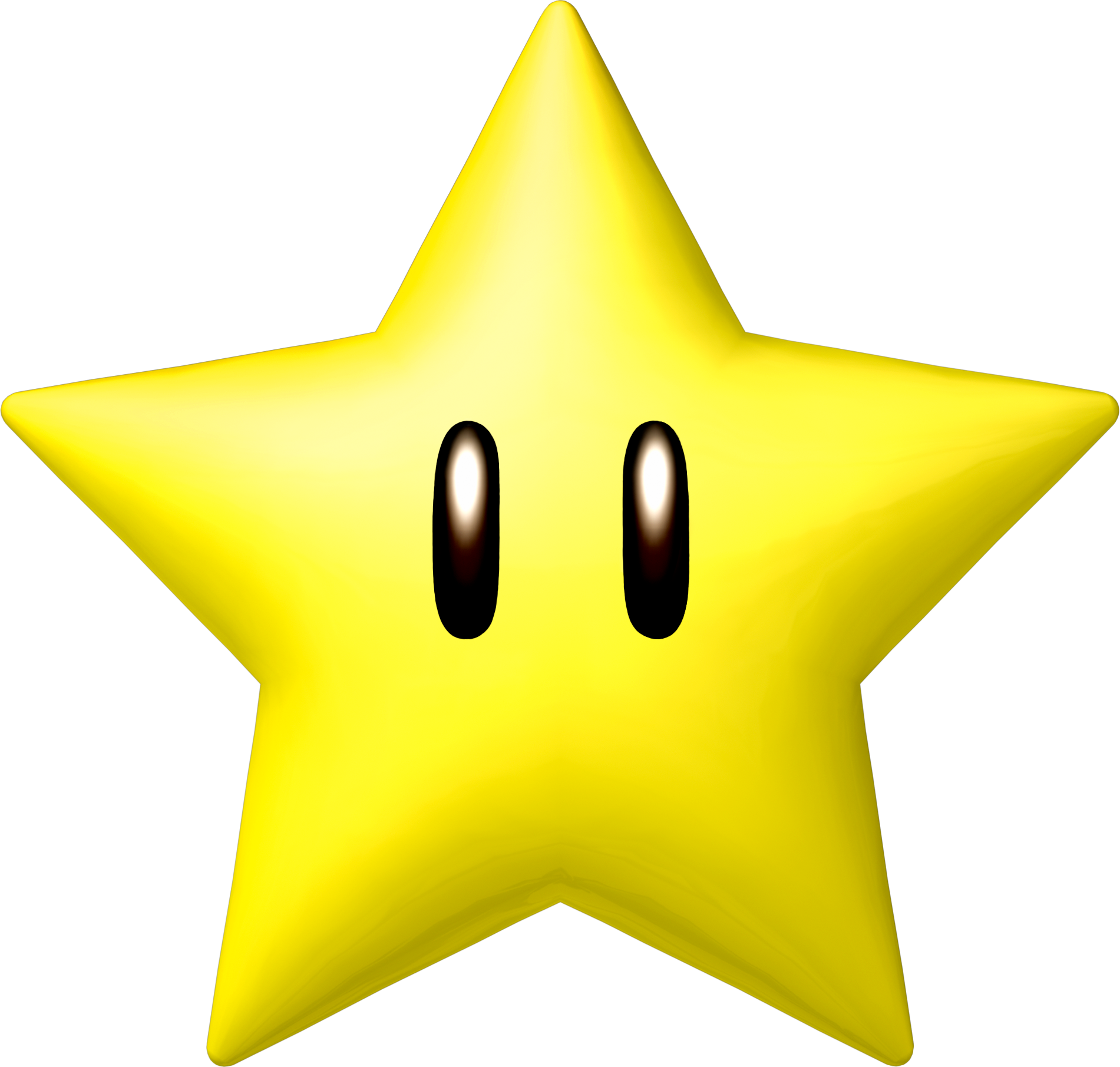 required) required) |
Blocks
| Block | Image | Function |
|---|---|---|
| ? Block |  |
Contains a coin or item when hit. |
| Brick Block | File:Brick Block.png | Breaks or contains coins when hit. |
| Block | File:UsedBlock NSMBWii.png | Block that can't break. When a Question Block is hit it turns into a Block. |
| Ice Block |  |
A block that is created by an enemy that was frozen with an iceball. They can be picked up and thrown like a barrel. |
| Super Guide Block | File:SuperGuideBlockNSMBW.png | Appears after Mario dies eight times in a row in one stage. When hit, Luigi clears the stage for Mario. |
| Jump Block | File:WGCBlock.PNG | A block that when Mario jumps on it, it makes him jump higher. |
| POW Block | File:POWBlockNSMBW.png | A block that causes a large tremor on the ground. |
| Light Block | File:Glow Block.PNG | A block that shines light in dark areas. |
| Dotted Line Block | File:Dotted Line Block Icon.png | A block that is transparent. A Switch is needed to activate the block. |
| Red Block |  |
A block that is activated by a Switch. |
| Square Cloud |  |
When activated a Lakitu appears and it throws coins. |
| Propeller Block |  |
A block that can be picked up and works like the Propeller Mushroom. |
| Flying ? Blocks | File:FlyingQuestionBlock-NSMBWii.png | A type of Question Block that flies in a rhythmic pattern to the music of a stage. Once hit, it becomes a Block. |
| Giant ? Block |  |
A huge question block that only appears in 6-5. Acts like a normal block. |
| Coin Block | File:Brick Block.png | A block that contains many coins. Looks just like a Brick Block and become an Block when empty. Pops out 5 Coins when used quick enough. |
| Roulette Block |  |
A block with various items scrolling on it. Mario can hit it, and release the power-up shown. |
| Stretch Block |  |
A block made up of 5 segments that stretches to act as a bridge in certain levels. |
| Ice Snake Block |  |
A slippery type of Snake Block only found in 3-Castle. When Mario steps on it, it starts to move like a snake. |
Items and objects
| Item | Image | Function |
|---|---|---|
| Super Mushroom | File:SuperMushroom.png | Turns Mario into Super Mario. |
| 1-Up Mushroom | File:NSMBwii 1upshroom.jpg | Gives the player an extra life. |
| Coin | File:NSMBwii coin.jpg | Collecting 100 of these gives the player an extra life. In Coin Courses, they are used to determine the player's position. |
| Fire Flower |  |
Turns Mario into Fire Mario. |
| Red Ring |  |
Makes 8 Red Coins appear. If the player collects all 8 coins before they disappear, they receive either a power-up which varies in between levels or 1-Up Mushroom depending on the player's current size. |
| Red Coin |  |
Collecting all 8 Red Coins that appear after passing through a Red Ring gives a Super Mushroom, Fire Flower or 1-Up Mushroom, depending on what power-up the player is currently using. |
| Blue Coin | File:Blue coin Wii.png | Just like normal Coins, but appear by hitting a P Switch. |
| Super Star | File:Star.PNG | Turns Mario into Invincible Mario. |
| Star Coin | File:STARCOIN!.png | Three of these are located in every course in hard-to-reach or hidden areas. They are used to buy Super Play movies in Peach's Castle. After collecting all Star Coins, all of the Toad Houses remain open and can be used without them disappearing. In Coin Battle World, they are worth ten coins. Also, if the player unlocks all the Star Coins in a world, they unlock the respective level in World 9. |
| Mini Mushroom | File:MiniMushroom NSMB Wii.png | Turns Mario into Mini Mario. |
| Propeller Mushroom | File:Propeller Mushroom.png | Turns Mario into Propeller Mario, and gives him a short flight. |
| Penguin Suit |  |
Turns Mario into Penguin Mario. Mario can shoot iceballs, slide on his belly, all along an improved swimming ability. |
| Ice Flower |  |
Turns Mario into Ice Mario, Mario can shoot iceballs to freeze most enemies. |
| Dash Coin | File:DASHCOIN.png | An outline of a coin that becomes a coin if Mario goes through them. |
| Berries | File:Berry Red.png | A berry that Yoshi eats. When Yoshi eats five berries, he makes an egg that contains an item. |
| Barrel |  |
A barrel that Mario can pick up and throw at enemies to defeat them and at coins to collect them. If another player touches a barrel while it rolls, they lose a life or their power-up. |
| Tilt Lift | A lift that the player can tilt by tilting the Wii Remote. It only reacts when a player is standing on it. | |
| Toad Balloon | Items that appear in the enemy course. Mario must collect all of them to clear the course. | |
| P Switch | File:PSwitch.PNG | Turns Brick Blocks in Coins or vice versa or it causes the revealing of Silver Coins. |
| ? Switch |  |
Changes or adds to an area, such as platforms, for a limited time. |
| ! Switch | File:Eventswitch.png | A switch that changes all the dotted lines into platforms in World 3-4. It causes the bridge in World 8-Bowser's Castle to drop Bowser in the lava. |
| Springboard |  |
A trampoline lets the player jump high into the air. It can be picked up and carried around. |
| Donut Block | File:Donut Lift.png | A platform that falls under weight if Mario stays there for too long. As Mini Mario, he is too light to make it fall, as such it becomes safer. |
| Checkpoint Flag |  |
A flag that acts like a checkpoint. It has Bowser's insignia, but if a player touches it, it is replaced by which ever character's symbol turned it. If that character is in his small form, he transforms into his Super form. |
| Beanstalk | Used as ladder that can lead to Coin Heaven, or a secret place. Comes out of a hidden block or brick block. | |
| RemoCon Clown | File:Hero CarNSMBW.png | A type of Koopa Clown Car that lets the player battle Bowser Jr.. |
| Water Ball | File:Giant Bubble NSMBW.png | Huge masses of water that float in the air; acts as if Mario and co. is in water. They are only found in World 7-2, along with Chain Chomps. |
| Yoshi Egg | An egg that Yoshi comes out of or produces after eating five berries. They contain Power Ups. The different colors released come at random but never the same one after each other. |
Development
According to Nintendo, Shigeru Miyamoto had been struggling to add multiplayer in a Mario game for a long time. They further explained that Miyamoto tried to experiment with multiplayer aspects at the start of most of his Mario projects. This can be seen in pre-release screenshots of games such as Super Mario 64 DS and New Super Mario Bros., as different multiplayer aspects were evidently intended for both of those games during the earlier stages of development. But when the experiments with multiplayer failed to come to fruition, the developers focused back to what they were used to, single-player, and, for both of the aforementioned games, multiplayer was put on the back burner and became a mere tag-on that used both the game's engine and a series of dissimilar mini-games. One of the reasons multiplayer was not achieved previously was due to technical limitations. With the Wii's hardware, it allowed Miyamoto to make sure the game had all the items and enemies in the screen at once, and having the camera focusing on all the players at once.[6]
Additionally, Nintendo is planning to add the new "demo play" feature to their future titles, with New Super Mario Bros. Wii being the flagship title for the feature. A patent on the game, then called "Kind Code", was filed by Miyamoto on June 30, 2008. It showed that it could come in three modes: Game (in which the player plays the game normally until they get stuck, at which point they can view a video that appears on the screen's top right corner on how to bypass the situation in question), Digest (in which the player watches the developers play through the game until the player decides to join the game at a particular point; the game cannot be saved in this mode), and Scene Menu (where players go directly to specific parts of the game without loading their games or watching the digest). In the final game, the Digest version of the "demo play" mode was released as "Super Guide"[7].
References to other games
- Donkey Kong: Broozers hit barrels when a player is near, rolling the barrel towards them, similar to Donkey Kong's ability to throw barrels in this game.
- Mario Bros.: The POW Block reappears and has the same design as in Mario Bros. The POW Block can also be carried. One underground Coin Battle area also bears some resemblance to the Mario Bros. arena.
- Super Mario Bros.: The secret "Level Clear" tune and fireworks are taken from this game. The first tunes from the overworld theme is played during the beginning of the Staff Roll. The overworld theme is once again used as a cover for the Toad Houses. Near the beginning of the game, Bowser Jr. states in a letter that he ordered his minions to stuff every Toad they see into a ? Block, which might be a reference to the fact that Bowser transformed them into ? Blocks, according to the instruction book. Also, Roy Koopa's Castle has three way corridors, with only one being the correct path. This puzzle mimics the puzzles in World 4-4, World 7-4, and World 8-4. In Coin Battle, a level similar to World 1-1 appears.
- Super Mario Bros.: The Lost Levels: World 2-4 features wind.
- Super Mario Bros. 3: The Penguin Suit is based on the suits in this game, mainly the Frog Suit. The Koopalings' battle theme is a cover and once again played when fighting against them. The Airship theme is a cover that plays on the Airships. The design on the Fortresses are based on the Fortress sprite in this game. The Enemy Courses are similar to the levels when fighting against a Hammer Bro, Fire Bro, Boomerang Bro, or Sledge Bro and even use a cover of the song. Also, reserved power-ups can be used on the world maps. The game features an inventory window rather than a summonable item. This window can only be accessed from the overworld, reminiscent of that in Super Mario Bros 3. Most of the Koopalings are fought in the same kind of land they are, like in Super Mario Bros. 3. For example, Lemmy Koopa was in charge of the ice-themed world in both games, and Wendy O. Koopa was in charge of the water-themed world in both games. In addition, Power-up Panels is likely based on a card-matching minigame in this game.
- Super Mario World: The design on the Fortress-doors leading to the boss is noticeably similar. Yoshis reappear, along with the sound heard when mounting onto Yoshi and the drumbeat that is added to the music, similar to this game. Parts of the castle BGM can be heard in the castle levels. The sound effect that plays when the invincibility wears off was taken from the P-Switch when the activation is going to stop, as well as the sound that plays when the Super Star power-up runs out. The World 9 is similar to the Star World and the Special World. Also, World 3 has a switch that activates blocks to appear. This may be a reference to the Switch Palaces in Super Mario World, without having to go through a level. The Koopa Clown Car returns.
- Super Mario World 2: Yoshi's Island: Just before the main boss of the world, Kamek appears and flies all over the room, using his magic on the room and boss. Kamek turns Bowser into a giant for the final battle.
- Donkey Kong Country: The animal buddy mechanics used in this game, are used on the Yoshis; players can only use Yoshi in certain levels, and they ditch him after clearing the level.
- Super Mario 64: "Inside the Castle Walls" is played inside Princess Peach's Castle. Also, when the mini-game Power-up Panels is lost (when the player gets two Bowser or Bowser Jr. cards), the short tune heard when trying to enter a locked door is played here. When the player goes into a Warp Cannon or aims a cannon in 1-up Blast, cannon sounds from this game are heard. How Chain Chomps are removed from their posts is reminiscent of how the Chain Chomp is this game is removed from its post in Bob-omb Battlefield.
- Mario Kart 64: About 30 seconds in the Rainbow Path, a cover from the Rainbow Road theme can be heard.
- New Super Mario Bros.: Most of the songs are covers, especially the "Level Clear" tune. The Mini Mushroom returns. Some text in New Super Mario Bros. Wii's instruction manual is reused from its instruction manual (for example, the Blunders and Game Over section in New Super Mario Bros.'s manual is reused in New Super Mario Bros. Wii's manual, except the word "whacked" is replaced with "clobbered").
- Yoshi's Island DS: Kamek turns Bowser into a giant for the final battle.
- Super Mario Galaxy: During the Staff Roll, an outtake of a Princess Peach voiceover states that she'll wait for Mario at the night of the Star Festival, but she is interrupted by Bowser. The 1-up sound effect from this game plays when the player gets a 1-up in New Super Mario Bros. Wii, but only from the speakers of the Wii Remote. In World 9, multicolor star-shaped objects fall from the sky, like Star Bits. Finally, the Ice Flower returns from this game, but has a different function (in Super Mario Galaxy, Ice Mario can walk on liquid and in New Super Mario Bros. Wii, he can throw ice balls). Some of the voice clips from this game are borrowed.
- Mario Kart Wii: The character's icons are reused in the character selection screen.
References in later games
- Super Mario Galaxy 2: The Checkpoint Flag appears in this game and it plays a similar role. The Cosmic Guide and the Tip Network are similar to the Super Guide and to the videos of the Princess Peach's Castle. The function of the World Maps are similar to those from this game.
- Donkey Kong Country Returns: The map screen has level pads that look highly similar to the ones from New Super Mario Bros. Wii. The pads even use the same colors; red for a non-cleared level, and blue for a cleared level. Super Kong is the equivalent of the Super Guide. During 2 Player mode, if either Donkey Kong or Diddy Kong lose a life and the other one is still alive, the Kong that was defeated floats back inside a DK Barrel hanging from a balloon, similar to the bubble system in this game.
- New Super Mario Bros. Mii: A very similar trial based on New Super Mario Bros. Wii.
- Super Mario 3D Land: Propeller Boxes are based on the Propeller Blocks in New Super Mario Bros. Wii. Stars can be earned on the files of both games.
- Mario Party 9: A lot of this game's content originated from New Super Mario Bros. Wii.
- StreetPass Mii Plaza: One of the Puzzle Swap panels in the StreetPass Mii Plaza app for the Nintendo 3DS is New Super Mario Bros. Wii.
- New Super Mario Bros. 2: The music is reused in this game, with added vocals to the overworld and athletic themes, as well as vocal riffs "bah" included in the Tower, Castle and Ghost House themes. Stars can be earned on the file in both games.
- New Super Mario Bros. U: This game is a sequel to New Super Mario Bros. Wii; many elements from this game return, such as Yellow Toad and Blue Toad, and the Propeller and Penguin Mushrooms.
- Super Mario 3D World: All of the multiplayer abilities return. Again, a Toad who looks like Blue Toad can be chosen as a playable character. Yellow Toad, however was replaced by Princess Peach in that game. And Propeller Boxes return once more.
- Yoshi's New Island: Bowser's sprite is heavily similar to the one used in this game.
- Mario Kart 8 / Mario Kart 8 Deluxe: One of the planes in Sunshine Airport has a logo for Propeller Toad Transport with an insignia of a Propeller Mushroom.
- Mario Tennis: Ultra Smash: Bowser Jr. uses his Junior Clown Car in the game.
Media
- For a complete list of media for this subject, see List of New Super Mario Bros. Wii media.
Gallery
- For this subject's image gallery, see Gallery:New Super Mario Bros. Wii.
- MarioNSMBWii.PNG
Mario
- Mario Yoshi NSMBW.png
Mario and Yoshi
- MarioPropella.png
Propeller Mario
- BlueToad.png
Blue Toad
- NSMBwii koopalings.png
The Koopalings
- BowserNSMBWii.png
Bowser
Pre-release and unused content
Princess Peach was going to be a playable character, and the Mega Mushroom was going to be a power-up. Pink Yoshi was going to be Red Yoshi and Light Blue Yoshi was going to be Blue Yoshi. There was no Ice Flower and Mini Mushroom could be obtained via Roulette Block. There was also going to be a chicken suit power-up. It was then replaced with the Penguin Suit. King Bills also have a death animation that goes unused.
Staff
- Main article: List of New Super Mario Bros. Wii staff
Nintendo Entertainment Analysis and Development developed the game, with the director being Shigeyuki Asuke and the producers being Takashi Tezuka and Hiroyuki Kimura.
Glitches
- Main article: List of New Super Mario Bros. Wii glitches
Trading Cards
- Main article: New Super Mario Bros. Wii trading cards
The New Super Mario Bros. Wii trading cards features various characters, enemies, items, and levels from the game. Each booster pack contains four regular cards and one each of Tips & Tricks, Standee, Foil and FunTats.
New Super Mario Bros. Wii Intermediate / Advanced Piano Solos
A book published by Alfred Music Publishing was released, containing sheet music for seventeen theme songs from the game.
Names in other languages
| Language | Name | Meaning | Notes |
|---|---|---|---|
| Japanese | New スーパーマリオブラザーズ Wii[?] Nyū Sūpā Mario Burazāzu Wī |
New Super Mario Bros. Wii | |
| Chinese | 新超級瑪利歐兄弟Wii (Traditional) Xīn Chāojí Mǎlìōu Xiōngdì Wii New 超级马力欧兄弟 Wii (Simplified)[8] New Chāojí Mǎlìōu Xiōngdì Wii |
New Super Mario Bros. Wii | |
| French | New Super Mario Bros. Wii[?] | - | |
| German | New Super Mario Bros. Wii[?] | - | |
| Italian | New Super Mario Bros. Wii[?] | - | |
| Korean | 뉴 슈퍼 마리오브라더스 Wii[?] Nyu Syuper Mario Beuradeoseu Wii |
New Super Mario Bros. Wii | |
| Spanish | New Super Mario Bros. Wii[?] | - |
Trivia
- This game's box artwork (along other images) was used for the Nintendo 3DS demo at E3 2010[9] and later reused in the Puzzle Swap game in the StreetPass Mii Plaza application from the same console.
- This is the first of two games released outside of Japan and South Korea to feature a different colored game box, the second being Mario & Sonic at the London 2012 Olympic Games. The box for New Super Mario Bros. Wii is red, as opposed to most other Wii games with a white box.
- On the cover of the game disc (the side opposite with the part that reads the console), Mario, Luigi, Blue Toad and Yellow Toad are positioned in the same way that the buttons on the European and Japanese SNES controller are.
- The current Mario and Luigi voice actor, Charles Martinet, says that this game is his favorite Mario game of all time.
References
- ^ Super Guide information at Kotaku.com
- ^ IR Information : Sales Data - Top Selling Software Sales Units - Wii Software (nintendo.co.jp)
- ^ nintendo.co.jp - New Super Mario Bros. Wii character page (Click on the blue circle with the arrow to reach the Koopaling page and click on the pictures to see the short bio of each of the Koopalings). Translation (Retrieved November 13, 2011)
- ^ Famitsu's Scans
- ^ http://wii.ign.com/dor/objects/14354229/super-mario-wii-2/videos/smbwii_gmp_gameopening.html Intro cinematic
- ^ Klepek, Patrick (6/2/2009) "New Super Mario Bros. Achieves Shigeru Miyamoto's Dream: Multiplayer - G4tv.com". G4TV. Retrieved 2009-6-2
- ^ Kotaku - Nintendo Patent Reveals Potential Paradigm Shift in Design - Wii
- ^ http://shield.nvidia.cn/games/geforce-now/new-super-mario-bros
- ^ http://www.youtube.com/watch?v=GYnyBxVhK_c&feature=player_embedded
External links
- Oceanian Website for New Super Mario Bros. Wii
- American Website for New Super Mario Bros. Wii
- European Website for New Super Mario Bros. Wii
- Japanese Website for New Super Mario Bros. Wii
- Taiwanese Website for New Super Mario Bros. Wii
- Hongkonger Website for New Super Mario Bros. Wii
- Chinese Website for New Super Mario Bros. Wii (From Nvidia)
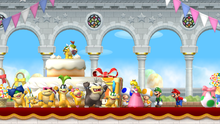
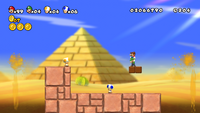

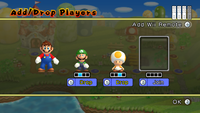
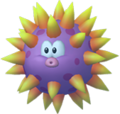




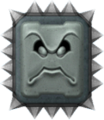






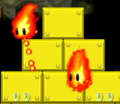






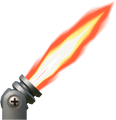
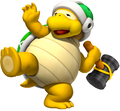




![Artwork of Fire Mario in New Super Mario Bros. (also used in New Super Mario Bros. Wii and Super Mario 3D Land)[1][2]](https://mario.wiki.gallery/images/thumb/8/8a/Fire_Mario.png/200px-Fire_Mario.png)
